“There were giants in the earth in those days…”
During the Pleistocene epoch of pre-history (three million to ten thousand years ago) many islands in the Mediterranean Sea provided the habitat of animals that developed in a unique fashion: they became either dwarfed or gigantic. For instance, there were dwarfed elephants (the smallest only three feet high at the shoulder) on Cyprus, Crete, Sicily, Malta, Sardinia, Melos,Melos and Delos, and dwarfed hippos on Cyprus, Crete, Sicily and Malta. Deer became dwarfed on Crete and Karpathos while the Balearic Islands produced a dwarfed antelope. Rodents became “gigantic” on Malta, Sicily, and Menorca. Swans and vultures became gigantic on Malta.

The two largest living terrestrial mammals, elephants and hippopotami, became dwarfed on some Mediterranean islands while other, normally small animals became larger. We shall explore man’s interpretation of their bones as the remains of humans, saints, ani-mals or monsters. Man did not use folklore to describe bones only on these islands; it is common all over the world. Pausanias (I. 35) refers to the discovery of a number of giant skeletons including one 15 feet long, all identified as the bones of Greek heroes.
Cyprus
The first person to find bones in Cyprus was the Dutchman, Cornelis de Bruijn, who traveled throughout the Levant and Cyprus in the 17th century. In his book (Reis en door de vermaardste delen van Klein Asia, 1698) he described a visit in 1683 to “a certain place in the mountains where bones of man and beasts are seen in the rock, grown together and petrified…. I reached my goal and had some bones hewn out of the rock. The most important was not dissimilar to a long bone of a human arm…. I also found .. . human and other bones, of many kinds, including many teeth of large dimensions.
“On the rocks I saw wax-candles, from which I opinioned that this place is held in venerance; as I was told, Greeks sometimes came to pray there, believing that possibly some bodies of their saints were buried there.”
The bone he believed to be a human long bone, which he pictures, is in fact a humerus of the Cypriote pygmy hippopotamus.
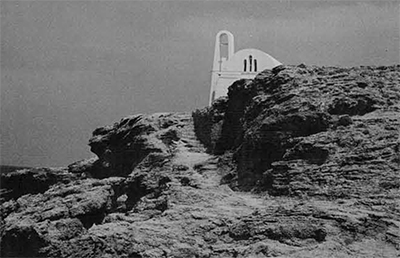
The next person to report bones of the hippopotamus was “General” (self-appointed) Luigi Palma di Cesnola, American Consul at Larnaca, and antiquarian and tomb robber extraordinaire. From just one archaeological site in central Cyprus, Idalion, he robbed 10,000 tombs! He was later to become the first director of the Metropolitan Museum of Art. Elizabeth McFadden has recently written a fascinating biography of di Cesnola, The Glitter and the Gold. At Cape Pyla, on the southern coast, di Cesnola was taken in the late 1860’s to a cave. He wrote (1877): “It was a large cavern which my guide called `Spilia Macaria,’ the entrance of which faces the sea. This cave contains a great quantity of bones, some of which competent authorities have recognized as human. It is about 60 feet above the level of the sea.
“I succeeded in penetrating into the cave, and found petrified bones on the floor and in the walls, forming a solid mass. How they ever came there will probably remain a mystery.
“My guide told me with religious awe they were the bones of ‘forty saints,’ and that a few years ago it had been the custom of the peasants of neighboring villages to make a pilgrimage to this cave, accompanied by their priests, on the anniversary of the 9th of March, but that the Greek Archbishop of Cyprus, who happened to be collecting his church dues at the time of one of these pilgrimages, ordered them to be discontinued.” In a letter written in 1875 by di Cesnola to a friend, John T. Johnson, he says that they were not the mass graves of humans, but the remains of “antedeluvian beasts.”
Miss Dorothea M. A. Bate, one of the first scientific workers on the Cypriote hippos, collecting on the island from 1902 to 1904, identified di Cesnola’s cave as Haghios (or Ayios) Saronda, “the cave to which formerly pilgrimages were made and candles burned in honour of the sacred remains of saints.” Another cave in the vicinity which Miss Bate discovered, Haghios Jannos, is also believed to harbor the remains of saints.
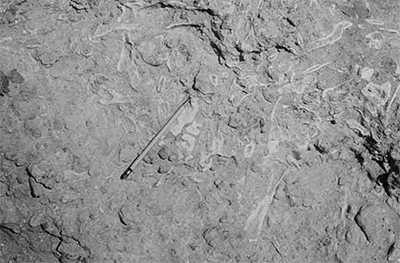
Two Dutch paleontologists, Drs. G. J. Boekschoten and P. Y. Sondaar, working on the island in 1969, learned that pilgrimages of a religious nature continue even today (1972). Rupert Gunnis, in his travelogue of Cyprus, Historic Cyprus (1936), gives us another interpretation of “Spilia Macaria,” calling it the “Cave of Forty Martyrs.” He states: “The sides, roof, and floor at the west end are full of the petrified bones of pygmy hippopotami though they are regarded by the villagers as the remains of Early Christian martyrs who were massacred there.”
Another locality, near the village of Ayios Georgios on the north coast, is a narrow rock ledge just outside of the small rock-hewn chapel of Ayios Phanourios. A bit higher up the cliff is the more recent whitewashed church of the same name. Gunnis described this site: “Beneath the chapel the rocks are full of fossil bones, called by the villagers the bones of St. Phanourios, but in reality they are the remains of the pygmy hippopotamus.
“St. Phanourios was a youth who lived in Asia Minor, heard the call of Christ and came to Cyprus. He sailed across in a small boat with only his faithful horse as his companion and, landing, tried to ride up the steep cliff, but his horse slipped and he and his steed were killed.
“The chapel is much resorted to by villagers, who dig out the fossil bones, and, powdering them, mix them with a drink of water. This draught is said to be a sovereign cure for nearly every known disease.”
Supposedly one can still see the footprints of his horse; I couldn’t. The custom of producing this draught is still practiced today.
St. Phanourios is the “Revealer” and can reveal a person’s desires once he drinks the mixture.
When it was decided to separate the dwarfed Cypriote hippopotamus from the genus Hippopotamus, the word Phanourios was chosen as the new genus after the saint whose name is frequently connected with Cypriote hippopotamus fossils.
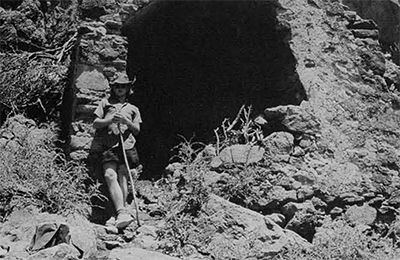
Another instance of the association of pygmy hippo bones with religion is found in Miss Bate’s field notes for 6-V-1902. This site was not seen since then until the author rediscovered it in June, 1973. This cave has been made into a little chapel by adding walls and a roof. Hippo bones are found in the worn limestone cave floor to the right of the entrance. According to Bate: “In the afternoon my men took me to another cave above Pascalis Chiftlik (farm). They called it St. Elias and consider it a sacred spot. A sort of entrance has been built round the mouth of the cave and in this there is an altar where they burn a native lamp—a woman came to light it while I was there. My men laughed at the idea of the hippos being saint bones and none of them minded my digging out some specimens.”
This chapel is now in disuse, though the altar remains as well as some colored plaster inside the cave. The lamp is no longer present.
The site of Dragontovounari (Greek for “Hill of the Dragons”), about five miles northwest of Ayia Irini (a mixed Greek and Turkish village), is in the Cape Kormikiti area of northwestern Cyprus. This is one of the richest hippo sites in Cyprus and also produced one molar of the dwarfed elephant, Elephas cypriotes Bate. At this site the bones are thought to be the remains of monsters—definitely not saints! Drs. Boekschoten and Sondaar (1972) heard the villagers of Ayia Irini “… interpret the large body of bonebreccia underneath the ‘Dragontovounari’ as the burial place of dragons drowned during a terrible flood, which is proven by the shells of oyster and scallop in the surrounding rock.”
The shells are part of the original cave in which the bones were preserved. The Miocene limestone of the cave walls contains the fossils which fell on or near the hippo bones on the cave floor when the cave fell apart due to atmospheric erosion.
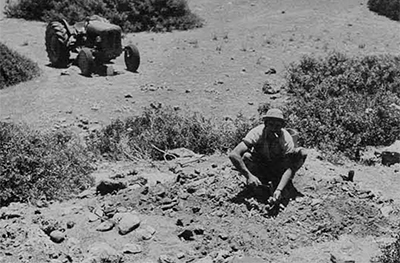
A new site was found in the southern foothills of the Kyrenia Mountains between the villages of Kato Dhikomo and Aghirda by the author in June, 1973. As my Turkish guides told me, around the turn of the century, an Englishwoman committed suicide by jumping off the top of a cliff. The small cave at the bottom of the cliff was used as her crypt, with the outside of the cave plastered over except for a small opening. Inside the cave were found hippo bones (thankfully, no human remains). Bones are also preserved in a layer below the plastered face.
While looking for a hippo site near the village of Akanthou in northern Cyprus, I met a Greek shepherd who told me of his finding “elephant teeth” near the church of Ayios Mikhalos. On examination, I realized that what he believed to be “elephant teeth” were in fact coral fossils, pieces of which occur in the fields and along the coast.
Crete
On Crete, an early mention of Pleistocene dwarfed animals (elephants, hippos and deer) is by Fabrequette, one-time Consul to Malta, who in 1887 made a reference to “fossilized human remains found, together with marine forms, near Khania.” They were not human, but were the bones of Pleistocene mammals.
In 1886, Charles Edwardes, in his Letters from Crete (1887) describes touring Crete with a group of priests and stopping at a cave: “Proceeding in, with lighted candles, we came to a cleft. Holding the taper against the wall, the superior stood and said: ” `Anthropoi!”
“On examination, the rock proved to be compounded of a vast gathering of bones, all crushed and petrified into a substance as hard as granite itself. They lay in confused strata, bones of men and animals, mixed with the original matrix of the rock; Father Jack and the superior went to and fro with their tapers, identifying this bone and that by touching the corresponding bone in their own musculature and animated bodies…. The monks say, ‘Ages ago! Ages ago!’ and that is all their tradition affirms about the matter. Probably. there was a village on the higher level of this peninsula; and this village was suddenly overwhelmed by the crashing down of a mountain-top.
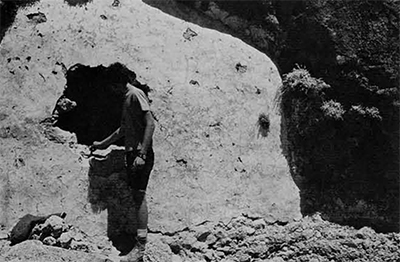
The Cretan rocks are not very old in the geological notion of time; so I am afraid these embedded fragments cannot claim to be parts of pre-Adamic man.” This view of a cave containing relatively recent human remains is not so strange as it might at first seem. There are actual accumulations of recent bones in Cretan caves. One is in the Cave of Melidhoni. In 1824, several hundred Cretans took refuge there from Turkish soldiers who were ravaging the area. When the Turks discovered that there were Cretans inside, they built a bonfire at the mouth of the cave and suffocated the Cretans. As John Bowman (1969) says in his Travelers’ Guide to Crete: “For decades afterwards, visitors to the cave report seeing the bones and skulls in the crevices and corners where the people had scrambled for air.” The bones of the dwarfed Cretan deer were supposedly found by Sir Arthur Evans in a shrine in the Minoan Palace of Knossos. If these really are the bones of the Pleistocene dwarfed deer, they were not contemporary with man and were set up as a shrine for some reverential reason.
Sicily
The first notice of fossils in Sicily—in this instance of dwarfed elephants—was by the 5th century B.C. philosopher, Empedocles of Acragas. He was the father of the science we now know as physics. He also was a doctor and a poet. He was the first to introduce a precise concept of “element” into science, cured a plague at Selinus, described “the first real experiment” in the West, wrote lyric poetry on Natural Selection, believed in reincarnation, and, finally, claimed to be a god! He thought that these bones were the skeleton of Homer’s Polyphemus (a Cyclops or Kyklops) who was 300 feet tall.
The Cyclopes, according to Homer’s Odyssey, were a gigantic and lawless race of shepherds who devoured humans. Their name is derived from the word meaning “round-eye” in reference to the one circular eye in the middle of their forehead. The term has also been explained to mean “wheel-eyed” since the eye was supposed to be as large as a wheel. Certain Cyclopes made thunderbolts for Zeus under Vulcan’s guidance. Their workshop was in Mount Etna or in several other volcanoes in Sicily. They lived along the southern and eastern coast of the island. Their association with Mount Etna is thought to stem from the glow in the night sky over the peak which was visible far out to sea when the volcano was alive.
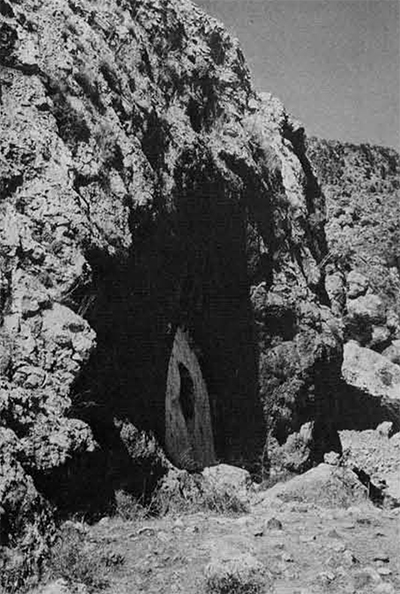
Odysseus in the Odyssey put out the eye of one Cyclops, Polyphemus, so he could escape from the island. The Cyclops Rocks at Aci Trezza. Sicily, are believed to be the stones hurled by Polyphemus at Odysseus during the latter’s escape.
In the 14th century, Giovanni Boccacio (the author of the Decameron), in the fourth book of his Genealogy of the Gods, refers to the bones of the Cyclops, citing Empedocles as his source.
In reference to the Cyclops belief, the Austrian paleontologist and founder of the science of paleobiology, Othenio Abel, working in the early 1900’s, has stated: “Sailors of Homeric days, blown off course and finding such skulls, had never seen elephants. Hence they hit on the idea that the skulls must be those of huge beings with one great eye in the middle of the forehead. Thus the myth of the one-eyed Cyclops probably originated—as, indeed, most legends of giants are based on finds of large primordial mammals.”
The Cyclops is based on the unique and greatly enlarged nasal opening of the elephant which to the unknowing looks like two eye-sockets merged into one in what appears to be the forehead.
In 1678, the German Jesuit scientist, Athanasius Kircher, published his Mundus subterraneus (“Underground World”) after examining the Sicilian bones. He was famous for his studies of languages and classical antiquity and for inventing the “burning mirror” and the “magic lantern.” His book is considered a milestone in the fields of volcanology and speleology, though he still thought that all of the fossils were the bones of giants. However, the giant is now only 30 feet tall! In this book he includes four pictures of the different “types” of giants.
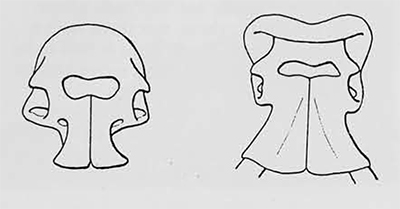
Kircher felt that the cause of volcanoes was in subterranean caves, some of which contained water or fire or air, He believed that in the air-filled caverns lurked “dragons.” In fact, the skulls of Pleistocene bears and rhinoceri were often explained as being the remains of dragons. In another one of Kircher’s books he pictures the types of cages Noah must have used for the different animals.
In Sicily, around 1829, there was a great demand for bones for the manufacture of lampblack, used in sugar refining. The bones from a large cave, the “Grotta di San Ciro” (about two miles from Palermo), were collected in large quantities and sent to England and Marseilles. Within the first six months of the operation, 400 quintals (40,000 kilograms) were sent from San Ciro, the vast majority of which were dwarfed hippo remains.
During this period a lively discussion arose about the origin of the bones. One Sicilian, Professor Ferrara, maintained: “… they consisted of the skeletons of elephants captured by Metellus from Hasdrubal 504 years before the Christian era and of the Hippopotamus imported by the Saracen rulers of Sicily during the Middle Ages.”
The dispute over the origin of the bones was the reason for the government investigating the cave and producing the first real scientific collection of remains.
Dr. John H. Cooke (1891) states that most of the caves in Sicily are: “… invested either with a mythical or an historical importance (and) from time immemorial have been credited as being the haunt of a gigantic race of ghouls.”
Malta
The first description of Maltese fossils is by Abela in his Sescrittone di Mahe (1647). He described teeth and bones of great dimensions which were thought to belong to the Cyclopes or ancient inhabitants of Sicily. These remains were referred to by Abela and others as belonging to the “Giant Epoch.” Abele states: “What further testimony can we desire of the habituation here of the Cyclops than that given us by the gigantic bones found in Malta (such as) a bone which the owner used as a cross-bar for the door! We ourselves have seen a molar tooth of the thickness of the finger, and an inch in length, which was extracted from a gigantic head.”
Dr. Andrew Leith Adams, collecting fossils in Malta around 1870, was told by a friend that even Maltese of considerable intelligence disliked his interference with the relics of the deluge; since they had been placed there in token of divine wrath, they should not be disturbed. Though Adams was unable to prove man’s association with the bones, a friend of his said: “… some future paleontologist may be more fortunate than you have been, and not only establish man’s presence there, but also show that he rode the donkey elephant!”
Dr. Cooke stated: “The ancient inhabitants of Malta, like those of the neighboring countries, were ever ready to assign to the heroic all that was in the least incomprehensible to them.”
Maybe the Maltese assigned what they did not understand to the heroic, but most people have assigned things they can not comprehend to the “monstrous.” To the dragons of Cyprus and the Cyclopes of Sicily we can well add today’s Loch Ness “monster.”
